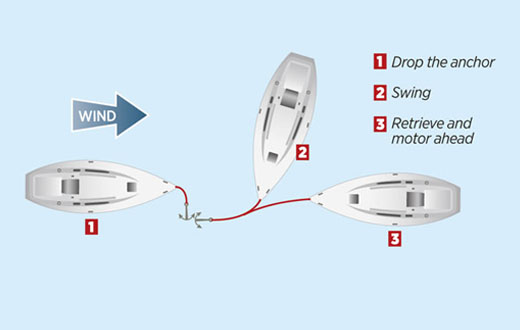|
More tips on using an anchor to help with boat handling, how to drop ground tackle by hand and how to recover a stuck anchor
More anchoring tips
Anchoring is such a huge subject that even with the main techniques taken care of, there are still any number of additional tips and methods which you hear of at the marina bar or read in textbooks, some of which are more useful than others. Here are a few I would recommend keeping in mind.
Drudging
Drudging is deliberately dragging the anchor to control your progress astern. Imagine that your engine has failed and you need to ease out of a crowded anchorage, or narrow cove, to a point where you can hoist your sails safely. You can allow the tide to push you out of the anchorage, but you need to control your speed. The trick is to haul in the anchor until it is just dragging on the sea bed. A crewman on the bow can hold the anchor cable and feel the anchorís contact with the bottom through the vibrations up the cable. If the helm calls out the depth as it changes, this will give the bowman an idea of whether he should be lifting or dropping the anchor to maintain contact with the seabed.
|
| Your best way out of a narrow or crowded anchorage may be to deliberately drag the anchor |
Turning on an anchor
If youíre in a tight spot and want to turn the boat, while you have some way on, drop the anchor quickly off the bow and use the weight of it and its cable as a pivot. This is the one occasion when allowing the chain to pile up on top of the anchor is a good idea. Youríe not trying to set the anchor, just provide a weight around which the bow can turn.

Paying out the cable
If you donít use a windlass to let out your chain, thereís some risk involved in dumping it all over the bow at once or in a hurry. Itís far better to pay it out at a steady rate as the yacht falls back on the tide.
|
| When paying out cable manually, itís important not to lose grip and drop the lot in a pile on the sea bed. Gloves may help |
If the chain sits in a pile on the sea bed, it can knot or bundle, reducing its scope. At worst, the pile can cover the anchor, or a loop can become wrapped around one of the flukes, preventing the anchor digging in properly. If you lower the anchor on a windlass, none of this will apply, because the cable is paid out steadily as the boat falls back.
Anchoring in rivers
Anchoring in rivers and estuaries, donít be lulled into a false sense of security. Wind over tide, or wind over river current, can create uncomfortable and challenging conditions. The Bahamian Moor can be useful if you need to keep swinging room to a minimum. Donít be tempted to try and lie to two anchors with the kedge off the stern. Boats donít tend to lie very well stern-to the tide, unless theyíre on a properly established mooring trot. Another useful tip is to choose an anchoring spot in the river where the wind is blowing across the tide or current, rather than up or down it, thereby avoiding any wind-over-tide situation.
|
| Yachts donít tend to lie well stern to the tide or wind so choose a spot giving cross-current winds |
Breaking out a stuck anchor
Getting our anchor stuck is what we all dread. Of course, the better prepared we are, the less likely this is to happen. A basic first check is to ensure the chart shows no cables, foul ground or sea bed conditions that might be troublesome.
|
| The yellow tripping line is set and buoyed. Bring the buoy back on board to avoid it being snagged |
In an emergency, when you have to anchor on a doubtful sea bed, always set a tripping line. This is simply a line to the crown of the anchor, so that you can try hauling a stuck anchor up from a different angle. Some people tie this to a buoy or fender, to mark the anchor and the lineís presence for other yachtsmen. I advise keeping the line and buoy on board. This prevents you or other yachts motoring over the line.
Without a tripping line, you just take in the slack on the cable and motor ahead. No luck? Then motor out to the side and try and break it out that way. Then motor behind it. You are trying to turn the anchor with these manoeuvres and dislodge it from what has trapped it.
Some textbooks advise that you move all your crew forward, then haul in the cable until itís drum tight, make fast and then move everyone aft again. This is said to lever the anchor free, sometimes, but I canít see it happening in reality, especially given that most of us cruise two-up.
If the anchor is truly stuck, thereís nothing to do but attach the bitter end of the cable to your biggest buoy, mark the co-ordinates and call a local diver.
Source - yachtingmonthly.com |








